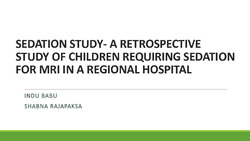Please use this identifier to cite or link to this item:
http://hdl.handle.net/11054/1311| Title: | Sedation study- a retrospective study of children requiring sedation for MRI in a regional hospital. |
| Author: | Babu, Indhumathi Rajapaksa, Shabna |
| Issue Date: | 2018 |
| Conference Name: | Ballarat Health Services 2018 Annual Research Symposium: research partnerships for population, people and patients; celebrating our research partnerships with the community in the Grampians region |
| Conference Date: | November 29th |
| Conference Place: | Ballarat |
| Abstract: | Background Many children undergo stressful procedures as part of their medical treatment. One of which is the Magnetic Resonance Imaging (MRI). MRI scans require patients to be still for prolonged periods. For children, a MRI scan can be confronting and scary. In our hospital we use sedation to minimise distress for the child and also optimise the quality of the MRI scan. Objectives/Aims The purpose of this study was to assess the quality, success and safety of the BHS Paediatric painless sedation CPG in managing children who required sedation for MRI scans. Method A retrospective study of sedation episodes were analyzed at BHS over the period of Sep 2015- Oct 2017. Data was collected from patients between the ages of 1 day to 18 years of age. Demographic data, fasting status, non pharmacological techniques, drugs used, adverse effects, indication and type of MRI were studied. Success and failure rate of sedation were calculated. A primary outcome was defined as completion of a quality MRI scan. A failed outcome was the MRI requiring rebooking. Adherence to local sedation protocol was checked. Results Of the total 80 episodes identified, MRI scans were requested for the following body area (74% Brain, 6% Spine, 10% Brain and spine, 1% Brain and orbit, 9% musculoskeletal). Chloral hydrate(oral), midazolam (oral, intranasal, buccal, and intravenous) and ketamine (intravenous) were the drugs used. The success rate was 89%. Eight for MRI Brain, one for MRI spine had unsuccessful sedation. Of these, 2 occurred when the protocol was followed, 7 episodes had variations in the protocol. Distraction, verbal reassurance and sleep deprivation were also used. Adverse events occurred on 30% of occasions. In 4% of occasions these were classed as severe eg desaturations, dizzy spells. Implications/Outcomes for Planned Research Project The availability of guidelines and facilities to provide sedation for children in rural/ regional hospitals minimizes travel, risks of GA and the waiting time. The sedation CPG safely manages children for this painless sedation and changes have been recommended to the CPG to address adverse events and better streamline choice of sedation for the different age groups. Final Thoughts Similar initiatives may be useful in other regional/ rural hospitals to help enhance the patient experience and minimize travel. |
| URI: | http://hdl.handle.net/11054/1311 |
| Internal ID Number: | 01264 |
| Health Subject: | MIDAZOLAM KETAMINE SEDATION PROTOCOL |
| Type: | Conference Presentation |
| Appears in Collections: | Research Output |
Files in This Item:
| File | Description | Size | Format | |
|---|---|---|---|---|
| Indhumathi BABU.pdf | ppt | 377.9 kB | Adobe PDF |  View/Open |
Items in DSpace are protected by copyright, with all rights reserved, unless otherwise indicated.
